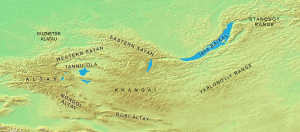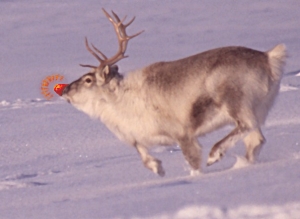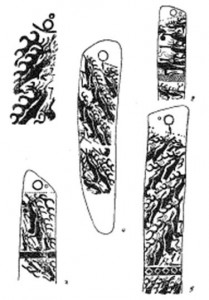Early Contacts With Reindeer

The mountains where reindeer domestication originated
http://en.wikipedia.org/wiki/File:Altay-Sayan_map_en.png
As mentioned before, during the Upper Paleolithic period, around 35,000 years ago, early humans depended a great deal on reindeer. At this time, around the last glacial maximum, humans encountered reindeer in many places because the climate allowed reindeer to live in many different places. Humans hunted reindeer for food, as well as material to make clothing and tools. Reindeer proved relatively easy to hunt for many reason. Their natural curiosity made it possible to trick reindeer with decoys and predictable migration routes made it possible for humans to exploit bottlenecks in migration routes and use traps to hunt them. Reindeer constituted a large portion of what early humans around this time hunted. They also feature prominently in cave art from this time (Smith 52).
Reindeer domestication began around 3,000 years ago in the Sayan region of the Altai mountains between Mongolia and China. Cave art from this area shows humans among many kinds of, presumably domesticated, animals, including reindeer. Other anthropological evidence points to the significance of reindeer in this area. Reindeer featured prominently in decorative arts as well as tattoos. There are also accounts of groups of people putting headdresses on horses to make the horses look like reindeer for various purposes. It is clear that reindeer played a significant role in Sayan culture.
As the climate warmed, reindeer herds migrated north from this mountainous region, and some groups of humans followed them. These humans became the nomadic groups that survived off reindeer in Siberia and continue to do so today. Reindeer played a central role in these groups’ physical lives as well as their conception of the spiritual world. Reindeer not only allowed them to survive in the harsh northern climate, but helped them explain the world around them (Vitebsky 30-31).
Reindeer People in Soviet Times

A present day Sami woman
http://upload.wikimedia.org/wikipedia/commons/6/69/Sami_woman_with_white_reindeer.jpg
In the 20th Century, the Soviet Union controlled most of the territory where wild and domesticated reindeer lived. Reindeer herding was hardly the type of modern, highly productive economic activity the Soviet Union wanted its citizens to engage in. The fact that various groups in the North depended on reindeer presented a problem for the Soviet Union. Throughout the 20th Century the Soviet Union tried to reshape the relationship between humans and reindeer and the image of the reindeer themselves.
The Soviet government tried to turn reindeer into a purely economic entity devoid of the spiritual meaning it held for centuries. The Soviets collectivized reindeer as they had with every other agricultural entity. Combating “backwardness” in the reindeer herding people was an especially important goal of the Soviet Union, and Soviet officials saw collectivization as a remedy for this backwardness. Collectivization of reindeer proved more difficult than other attempts at collectivization. On the Kola peninsula, the Kola people engaged in reindeer herding. When Soviet authorities attempted to collectivize the reindeer herds, many herders simply slaughtered their reindeer and ate them instead of turning them over to the authorities. This was not a unique occurrence in collectivization drives. What made reindeer collectivization more difficult was the reindeer themselves. As noted in the Reindeer Ethology section of this blog, reindeer follow migration routes over vast distances every year. Reindeer migration routes challenged Soviet notions of rational use of space. Soviet officials attempted to alter the migration routes by shortening them and setting new, shorted routes, but these attempts met with failure (Bruno 119, 123-4).
The Soviet Union also tried to combat the spiritual significance of the reindeer to the Northern reindeer herders. Reindeer featured heavily in the folklore of the Sami people of the Kola peninsula. The Sami practiced a shamanic religion that the reindeer played a crucial role in. The Russian government tried to force Christianity on the Sami during the Tsarist period. Like so many other groups of the time, the Sami’s conversion to Christianity was superficial. They retained many of their shamanic practices with a thin veneer of Christianity. Into Soviet times, the Sami celebrated shamanic holidays and much of their religious practices kept their shamanic tone. The Soviet Union also attempted to combat this backwardness of the Sami. Soviet authorities replaced Sami holidays with the Holiday of the North, which included reindeer sled races. Reindeer received awards for their merit just like any Soviet citizen could. Many journalists of the time extolled the reindeer for their productive capacity. Through these efforts, Soviet officials tried to move reindeer from the realm of the sacred into the everyday (Bruno 128).
Reindeer were a central part of life for reindeer herders in the Eurasian north. They featured heavily in the religion of the people who herded them since they were first domesticated in the Altai mountains. In the 20th century the Soviet Union tried to recast reindeer as a modern form of economic activity. It tried to reshape the lives of its northern citizens in a way that conformed to their notions of rational productivity and modernity.
Rudolph, The World’s Most Famous Reindeer

The Real Rudolph
http://upload.wikimedia.org/wikipedia/commons/3/33/Rudolph_the_Red-Nosed_Reindeer.jpg
Today, reindeer do not feature prominently in the culture of most groups of people. In modern times, perhaps the most visible reindeer in society are Rudolph and Santa’s other reindeer. Santa and his reindeer first appeared in an 1822 poem by Clement C. Moore. Moore studied folklore and wrote the famous poem about the night before Christmas. He combined Dutch, German, and Scandinavian folklore to create the iconic image of Santa and his flying reindeer. The poem was incredibly popular and numerous versions are still read today (Smith 1-3).
Rudolph, the famous reindeer with a red nose, began as an advertising gimmick by a group of American department stores in 1939. He acted as a mascot for the stores around Christmas. Robert L. May based Rudolph on the Hans Christian Andersen story, “The Ugly Duckling.” It was not until 1949, that Gene Autry recorded the famous song that is so well known today and established the Rudolph narrative (Smith 3-5).
Since reindeer are so limited in their geographic distribution, Rudolph the Red-Nosed Reindeer and the rest of Santa’s reindeer are the only reindeer most people come into contact with.

